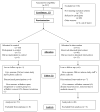Impact of a telephone-based physical activity intervention upon exercise behaviors and fitness in cancer survivors enrolled in a cooperative group setting
- PMID: 22113257
- PMCID: PMC3353544
- DOI: 10.1007/s10549-011-1882-7
Impact of a telephone-based physical activity intervention upon exercise behaviors and fitness in cancer survivors enrolled in a cooperative group setting
Abstract
Observational studies demonstrate an association between physical activity and improved outcomes in breast and colon cancer survivors. To test these observations with a large, randomized clinical trial, an intervention that significantly impacts physical activity in these patients is needed. The Active After Cancer Trial (AACT) was a multicenter pilot study evaluating the feasibility of a telephone-based exercise intervention in a cooperative group setting. Sedentary (engaging in <60 min of recreational activity/week) breast and colorectal cancer survivors were randomized to a telephone-based exercise intervention or usual care control group. The intervention was delivered through the University of California at San Diego; participants received ten phone calls over the course of the 16-week intervention. All participants underwent assessment of physical activity, fitness, physical functioning, fatigue and exercise self-efficacy at baseline and after the 16-week intervention. One hundred and twenty-one patients were enrolled through ten Cancer and Leukemia Group B (CALGB) institutions; 100 patients had breast cancer and 21 had colorectal cancer. Participants randomized to the exercise group increased physical activity by more than 100 versus 22% in controls (54.5 vs. 14.6 min, P = 0.13), and experienced significant increases in fitness (increased 6-min walk test distance by 186.9 vs. 81.9 feet, P = 0.006) and physical functioning (7.1 vs. 2.6, P = 0.04) as compared to the control group. Breast and colorectal cancer survivors enrolled in a multicenter, telephone-based physical activity intervention increased physical activity and experienced significant improvements in fitness and physical functioning. Lifestyle intervention research is feasible in a cooperative group setting.
Conflict of interest statement
References
-
- Holmes M, Chen W, Feskanich D, Kroenke C, Colditz G. Physical activity and survival after breast cancer diagnosis. Journal of the American Medical Association. 2005;293:2479–2486. - PubMed
-
- Holick C, Newcomb P, Trentham-Dietz A, Titus-Ernstoff L, Bersch A, Stampfer M, Baron J, Egan K, Willett W. Physical Activity and Survival after Diagnosis of Invasive Breast Cancer. Cancer Epidemiology, Biomarkers & Prevention. 2008;17:379–386. - PubMed
-
- Pierce J, Stefanick M, Flatt S, Natarajan L, Sternfeld B, Madlensky L, Al-Delaimy W, Thomson C, Kealey S, Hajek R, Parker B, Newman V, Caan B, Rock C. Greater Survival After Breast Cancer in Physically Active Women With High Vegetable-Fruit Intake Regardless of Obesity. Journal of Clinical Oncology. 2007;17:2345–2351. - PMC - PubMed
-
- Irwin M, Smith A, McTiernan A, Ballard-Barbash R, Cronin K, Gilliland F, Baumgartner R, Baumgartner K, Bernstein L. Influence of pre- and postdiagnosis physical activity on mortality in breast cancer survivors: the health, eating, activity, and lifestyle study. Journal of Clinical Oncology. 2008;26:3958–3964. - PMC - PubMed
Publication types
MeSH terms
Grants and funding
LinkOut - more resources
Full Text Sources
Medical
Miscellaneous


